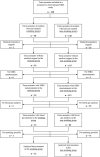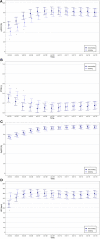Increased Risk for Cerebral Hypoxia During Immediate Neonatal Transition After Birth in Term Neonates Delivered by Caesarean Section With Prenatal Tobacco Exposure
- PMID: 34888265
- PMCID: PMC8650081
- DOI: 10.3389/fped.2021.747509
Increased Risk for Cerebral Hypoxia During Immediate Neonatal Transition After Birth in Term Neonates Delivered by Caesarean Section With Prenatal Tobacco Exposure
Abstract
Introduction: Maternal tobacco smoking during pregnancy is a global health problem leading to an increased risk for fetal and neonatal morbidities. So far, there are no data of the potential impact of maternal smoking during pregnancy on the most vulnerable period after birth - the immediate postnatal transition. The aim of the present study was therefore, to compare cerebral oxygenation during immediate postnatal transition in term neonates with and without prenatal tobacco exposure. Methods: Included in this post-hoc analysis were healthy term neonates, with measurements of cerebral oxygenation (INVOS 5100C) during the first 15 min after birth, and for whom information on maternal smoking behavior during pregnancy was available. Neonates with prenatal tobacco exposure (smoking group) were matched 1:1 according to gestational age (±1 week), birth weight (±100 grams) and hematocrit (±5 %) to neonates without (non-smoking group). Cerebral regional tissue oxygen saturation (crSO2), cerebral fractional tissue oxygen extraction (cFTOE), arterial oxygen saturation (SpO2) and heart rate (HR) within the first 15 min after birth were compared between the two groups. Results: Twelve neonates in the smoking group with a median (IQR) gestational age of 39.1 (38.8-39.3) weeks and a birth weight of 3,155 (2,970-3,472) grams were compared to 12 neonates in the non-smoking group with 39.1 (38.7-39.2) weeks and 3,134 (2,963-3,465) grams. In the smoking group, crSO2 was significantly lower and cFTOE significantly higher until min 5 after birth. HR was significantly higher in the smoking group in min 3 after birth. Beyond this period, there were no significant differences between the two groups. Conclusion: Cerebral oxygenation within the first 5 min after birth was compromised in neonates with prenatal tobacco exposure. This observation suggests a higher risk for cerebral hypoxia immediately after birth due to fetal tobacco exposure.
Keywords: NIRS; cerebral oxygenation; immediate neonatal resuscitation; maternal smoking; near infrared spectroscopy; nicotine; prenatal tobacco exposure; term neonates.
Copyright © 2021 Wolfsberger, Bruckner, Schwaberger, Mileder, Pritisanac, Hoeller, Avian, Urlesberger and Pichler.
Conflict of interest statement
The authors declare that the research was conducted in the absence of any commercial or financial relationships that could be construed as a potential conflict of interest.
Figures


Similar articles
-
Cerebral Oxygenation in Neonates Immediately after Cesarean Section and Mode of Maternal Anesthesia.Neonatology. 2019;116(2):132-139. doi: 10.1159/000499046. Epub 2019 May 16. Neonatology. 2019. PMID: 31096224
-
Fetal Inflammatory Response Syndrome and Cerebral Oxygenation During Immediate Postnatal Transition in Preterm Neonates.Front Pediatr. 2020 Jul 22;8:401. doi: 10.3389/fped.2020.00401. eCollection 2020. Front Pediatr. 2020. PMID: 32793528 Free PMC article.
-
Cerebral oxygenation immediately after birth and long-term outcome in preterm neonates-a retrospective analysis.BMC Pediatr. 2023 Mar 30;23(1):145. doi: 10.1186/s12887-023-03960-z. BMC Pediatr. 2023. PMID: 36997902 Free PMC article.
-
Cerebral oxygenation measurements during immediate neonatal transition in the delivery room: a systematic review.Pediatr Res. 2025 May 12. doi: 10.1038/s41390-025-04084-z. Online ahead of print. Pediatr Res. 2025. PMID: 40355540
-
Cerebral Tissue Oxygenation during Immediate Neonatal Transition and Resuscitation.Front Pediatr. 2017 Feb 23;5:29. doi: 10.3389/fped.2017.00029. eCollection 2017. Front Pediatr. 2017. PMID: 28280719 Free PMC article. Review.
Cited by
-
Developmental dyslexia in children with perinatal exposure to hypoxia: A systematic review.PLoS One. 2024 Sep 12;19(9):e0308497. doi: 10.1371/journal.pone.0308497. eCollection 2024. PLoS One. 2024. PMID: 39264879 Free PMC article.
-
Cerebral fractional tissue oxygen extraction (cFTOE) during immediate fetal-to-neonatal transition: a systematic qualitative review of the literature.Eur J Pediatr. 2024 Sep;183(9):3635-3645. doi: 10.1007/s00431-024-05631-2. Epub 2024 Jun 11. Eur J Pediatr. 2024. PMID: 38861023 Free PMC article.
References
-
- DiFranza JR, Lew RA. Effect of maternal cigarette smoking on pregnancy complications and sudden infant death syndrome. J Fam Pract. (1995) 40:385–94. - PubMed
-
- Walsh RA. Effects of maternal smoking on adverse pregnancy outcomes: examination of the criteria of causation. Hum Biol. (1994) 66:1059–62. - PubMed
LinkOut - more resources
Full Text Sources

